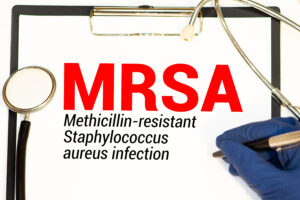A US study describes a new antibiotic against methicillin resistant Staphylococcus aureus. It is a lysin-based antibacterial agent.
Physicians have been looking for years for a solution regarding the increasing antibiotic resistance problem. But several attempts in the past have failed.
Staphylococcus infections are the most common bacterial infections of human skin, of soft tissue, joints, bones, and pneumonia. In addition, it can cause endocarditis (=infection of heart valves) and lead to blood poisoning (septicemia).
Staphylococcus aureus is the underlying bacterium behind staph infections. With the introduction of new antibiotics it takes only 1 to 2 years before this bacterium learns to become resistant. Researchers noticed that the bacteria start to produce lysins and suddenly they are resistant to the latest antibiotic. Further research zeroed in on lysostaphin, which was active against resistant Staphylococcus bacterial strains.
Deimmunized lysostaphin
Lysostaphin is an antibacterial peptide described here in detail. But there still was some interference with immunologically active surface antigens that scientists were later able to overcome. Researchers succeeded lately in removing some of the surface antigens and develop deimmunized lysostaphin. This is what this publication is all about.
It describes how T cells cannot detect the surface antigen properties of deimmunized lysostaphin. This way none of the strength of deimmunized lysostaphin gets lost in the fight against resistant staphylococcus that normally form anti-drug antibodies. Researchers pointed out the importance of the deimmunization process to make deimmunized lysostaphin invisible to the T cells of the immune system.
Vigorous testing of deimmunized lysostaphin
The researchers who investigated the efficiency and safety of deimmunized lysostaphin did the following tests.
- Although lysostaphin was deimmunized, it retained potent in vitro and in vivo anti-staphylococcal activity. In vitro studies involving Petri dishes with methicillin resistant Staphylococcus aureus showed the effectiveness of deimmunized lysostaphin. In vivo testing in a mouse and rabbit model also showed effectiveness.
- Deimmunized lysostaphin showed reduced immunogenicity in vivo. Researchers tested this in mice and compared the results to regular lysostaphin, where there was a swift immunological response.
More points regarding deimmunized lysostaphin
- Immune evasion allows for repeated efficient dosing of deimmunized lysostaphin. This means that the physician can administer the antibiotic (the deimmunized lysostaphin) to fight the methicillin resistant Staphylococcus aureus with several daily doses.
- The deimmunization process allows deimmunized lysostaphin to evade the immune response that occurs to regular lysostaphin. This prevents future resistance development. It also prevents that the immune responses weaken the anti-methicillin resistant Staphylococcus aureus response.
- Researchers showed in a difficult rabbit endocarditis model that deimmunized lysostaphin treats MRSA infection successfully. Endocarditis is an infectious disease, which is both difficult to treat in rabbits, but also in humans. For this reason, rabbits are often used as a model when new antibiotics are developed. If they are successful in the rabbit model they often get approval later for human treatments.
Deimmunized lysostaphin in humans
Unfortunately, we are still a few years away from using deimmunized lysostaphin in humans. After successful use of lysostaphin in mice and rabbits the next logical application is to launch human clinical trials. I am convinced that this will be the next step and very likely will be successful.
Conclusion
Researchers found a new antibiotic against methicillin resistant Staphylococcus aureus in a lysin-based antibacterial agent. This peptide has surface antigens that scientists had to removed to make it more effective. The end result was a deimmunized lysostaphin. Researchers tested this new antibiotic that is effective against many antibiotic resistant strains of bacteria successfully in mice and rabbits. The next step is testing in humans. This involves several phases of clinical trials. These clinical trials have to show that there is a lack of toxicity. In addition, they have to show that the new antibiotic is effective against resistant bacteria. I estimate that this process can still take about 5 years from now before the clinician can use this antibiotic routinely. As the new antibiotic is a polypeptide, it the patient cannot take it orally, as the gut is digesting it. The patient has to take it by injection.






